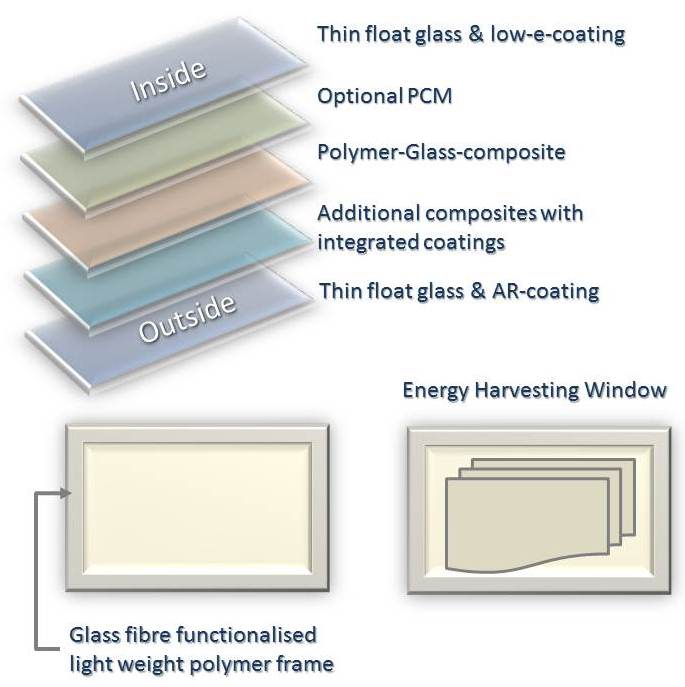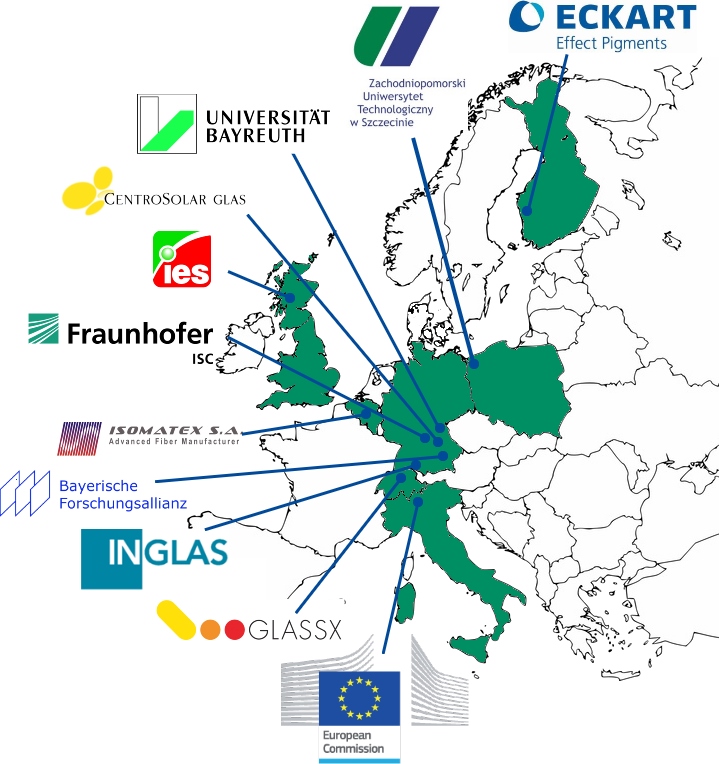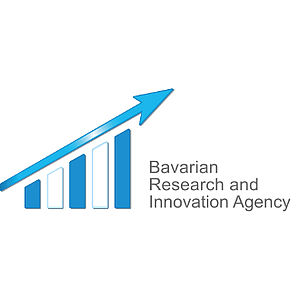
HarWin

New Materials for Windows of the Future
The ever-growing impact of climate change and the shortage of resources show a significant need for action, especially when it comes to energy and material consumption in building and utilization of buildings in the next few decades. Windows and facades play a major role in this context. By using innovative polymer glass composite materials and the requisite process technologies, it is possible to lower weight, energy consumption and costs considerably during production. When installed in buildings, windows make particularly efficient use of daylight, thus contributing to a lower energy consumption. The use of multilayered systems results in multifunctional windows and facades that help regulate temperature, humidity and noise and thus contribute to living comfort.
HarWin (Harvesting solar energy with multifunctional glass-polymer windows) is a research project that is funded as part of the Seventh Framework Programme (FP7) with the goal of fulfilling the EU Commission's objective in making buildings more energy-efficient by using new materials and technologies. The basis for the HarWin project was established by the Bavarian Research Association FORGLAS (multifunctional materials consisting of glass for energy-efficient building technologies), in which the project partners have researched part of the materials that are used in the HarWin project. The Research Association was funded by the Bavarian Research Foundation. The objective of the resulting EU project now is to optimize these materials and further the development of laminated glass panes. The decisive components of the new polymer glass composite materials are glass particles in ball form, which decrease thermal conduction, facilitate sound insulation, regulate humidity and increase the mechanical properties of the windows. The challenge is to combine these functional characteristics into the new window pane with sufficient transparency.
The new lightweight windows will comprise the following layers:
Project Overview
Project aims and fields of work
The laminated glass that is currently available for lightweight construction applications is especially efficient when it comes to use of resources in production compared to traditional window glass but is not suited for windows used in buildings. The degree of thermal conduction is too much and exterior sound cannot be dampened. That is why HarWin has taken it upon itself to further develop the existing laminated glass while simultaneously keeping weight as low as possible in order to ensure an optimum use of sunlight for the energy balance of modern and older buildings. HarWin is also intends to take the research project to the next step and the partners are striving for a direct industrial implementation of the results upon conclusion of the project.
The HarWin Consortium has set itself the following goals:
Development of new, lightweight composite materials for window glass and frames
The laminated and coated glass panes combine light, heat, noise and humidity control. Fibre-reinforced structures ensure sufficient stability of window glass and frames. Computer simulations will be used to test the applicability of new windows in various types of buildings.
Integration of components for utilizing solar energy
The layers that are used can transform UV light into visible light. Materials are also implemented which allow a reversible heat storage and release. Transmission, reflection and absorption of light and heat are adapted on both sides of the window to the desired level of comfort.
Life cycle assessment and performance analysis
The durability of the new windows as well as the effectiveness of the individual components and the buildings are analyzed during the course of material and component development. The findings determine which materials and functions are to be selected and whether the new product should be integrated in different buildings.
The new windows should have the following characteristics:
- Reduced weight
- Reduced material usage
- Lower energy consumption during their production
- Usage of recyclable materials
- Noise and heat insulation
- Heat and moisture regulation
- High strength and stability
- High transparency
- Size scalability for multi-purpose use
Target group
The HarWin project results are of significance to the following players:
- The European construction sector (window manufacturers, architects, house builders etc.)
- Players in energy supply
- Political decision-makers
- Interested members of the public
The HarWin consortium informs all the players concerned of the project results by issuing scientific publications, participating in specialist conferences and trade fairs, organising regular workshops and creating information material of interest to the public.
BayFOR as a partner
The Bavarian Research Alliance has been actively involved in the development and professional preparation of the EU application and now supports HarWin as a partner of the international consortium with project management and dissemination of project findings throughout the entire project.
Dr. Panteleïmon Panagiotou, department head at BayFOR, is in charge of HarWin project management.
Dr. Nico Riemann has supported the coordinator Prof. Dr. Monika Willert-Porada during the application and negotiation phase and is responsible for overseeing the dissemination of project results as part of the "Dissemination and Exploitation" work package. In this case, BayFOR has assumed the public relations activities for HarWin and the responsibility of disseminating the scientific project results and communicating them to the corresponding target groups.
Dr. Claudius Mott has been commissioned as project manager to handle the administrative and financial management and organize internal communication within the project.
Funding period
The HarWin project (Harvesting solar energy with multifunctional glass-polymer windows) has started on September 1st, 2012. The total budget is €4.9 million. As part of the EU’s Seventh Framework Programme, HarWin is funded with € 3.4 million over 36 months.
The topic "Smart Windows" was published with the announcement of the Energy-efficient Buildings Initiative (EeB Initiative), which was founded in 2009 as a result of the international economic crisis. The EeB Initiative is responsible for implementing the objectives of the EU Commission to decrease energy consumption in buildings and to bolster Europe's construction industry.
Consortium
Prof. Dr. Monika Willert-Porada, head of the chair of materials processing at the University of Bayreuth, coordinates the project. The multinational consortium comprises eleven partners from Belgium, Germany, Finland, Italy, Poland, Switzerland and Great Britain. With the University of Bayreuth, there are a total of six representatives from Bavaria. Universities, research institutes and innovative SMEs and large-scale companies work closely together in HarWin in order to address both the scientific and industrial challenges.
In this context, the partners provide expertise from the following areas:
- Materials science and engineering
- Mechanical engineering and production technologies
- Computer simulations are used to facilitate a better understanding of the interaction between environmental influences, material properties, buildings and the associated infrastructure
As a result, the consortium covers the entire value chain that is necessary for developing new windows and facades. The aim is to maintain an active dialogue with an external industrial working group to disseminate project results and to utilize the expertise of other industrial partners outside of the consortium.
The consortium is based on the network formed by the Bavarian Research Association FORGLAS and thus continues the ideas and developments made in FORGLAS on a European level. The University of Bayreuth, Fraunhofer Institute for Silicate Research (FhG-ISC) and two SMEs, Eckart GmbH and Centrosolar Glas GmbH & Co. KG, were involved in FORGLAS and participated in the development of functionalized, glass-based materials for energy-efficient building technologies.
Academic partners and research institutions
University of Bayreuth, Germany
Fraunhofer Institute for Silicate Research (FhG-ISC), Germany
Joint Research Centre - European Commission (JRC-IECS), Italy
West Pomeranian University of Technology, Poland
Companies
Centrosolar Glas GmbH & Co. KG., Germany
Eckart Pigments KY, Finland
GLASSX AG, Switzerland
InGlas Produktions GmbH, Germany
Integrated Environmental Solutions, Great Britain
Isomatex SA, Belgium
Bavarian Research Alliance GmbH, Germany
Associated partners (from Bavaria)
Eckart GmbH, Germany
New Materials Bayreuth GmbH, Germany
Further information
Official HarWin website: www.harwin-fp7.eu
Your contacts at BayFOR

Dr. Nico Riemann
Deputy Head of Unit and Scientific Officer Information & Communication Technologies |
Engineering & Natural Sciences
Phone: +49 911 50715-910
Email: riemann@no-spam-pleasebayfor.org






